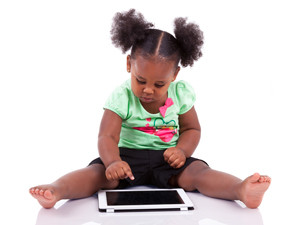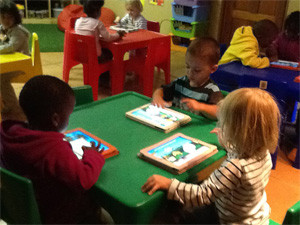
As digital technologies become ever more pervasive, a preschool in Bryanston, Johannesburg, has implemented iPads in the classroom.
The Bryanston campus of The Little Ashford Preschool (The LAP), which opened in September 2011, has the motto: "Innovatively equipping your kids for the future" and introduces children to new technology early on, while also using it to improve parent-teacher communication.
The school's principal, Marli Hoffman, says the school offers entry-level, 16GB iPads with WiFi access, at a subsidised rate of R3 000 for its 37 children. "Because it was part of the launch of the school, it was outlined from the outset for parents that the iPad would be part of the expenses," says Hoffman, adding that each child at the school has their own iPad, which they keep and that goes home with them on a daily basis.
"We do daily reports on the iPads for each individual child to let the parents know how their child is doing and what they did that day at school."
Hoffman says everything installed on the children's iPads is educational and age-appropriate. "Technology and media should not replace activities such as creative play, real-life exploration, physical activity, outdoor experiences, conversation, social interactions or any activities that are important for children's development.
"Technology and media is used to support learning and is not an isolated activity. It is used to expand and enhance young children's access to new content."
Age-appropriate
"We have a baby class that's from three months to when they are comfortable on their feet (which is anything from 12 months to 15 months). They don't have their own iPads, but the teachers will occasionally use an iPad to read them a story or show them shapes and so on," says Hoffman.

"Generally, from two-years-old, we get them to start using the iPads, but literally for just five minutes a day. The most important thing to know is that the iPads are in addition to anything we would traditionally do. They are not replacing anything. They enhance the teaching and the learning experience."
The two-year-olds start with basic apps on their iPads, such as Talking Tom. "It's just about getting them used to interacting with the tablet at this stage," says Hoffman, adding that the interaction with the tablets is scaled up for the older children.
"We start doing things with shapes and colours as well as theme-based content." Hoffman explains the school has a different theme for its classes every two weeks. "Our teachers create their own videos for classes using iMovie, and download relevant content from YouTube for the themed lessons.
"With the older kids there are some really nice apps available, including ones for learning to write and numeracy skills. So the iPads are just used together with our curriculum to enhance the whole teaching experience. The key thing is to get the kids comfortable with technology from an early age."
Hoffman adds: "The brain physically grows 80% between the age of zero and six, so the amount of information you can actually take in during that time is incredible. We're equipping them for the future."
The LAP's Saxonwold campus, which has 120 children, is also looking at implementing iPads in the classroom from next year. "It was easier for us to pilot the project here, as opposed to at the established branch of the school. When we roll it out there, there will also be a media library at the school, which will cater for those children whose parents don't necessarily want to buy an iPad," explains Hoffman.
Positive results
As mobile technologies make their way into the classroom, there have been some early studies that point to the benefits of tablets for improved literacy at a young age. In the Auburn School District, in Maine in the US, researchers randomly selected eight of 16 preschool classes from the district and all the children in those classes were given iPads to use at home and at school. The other classes in the district acted as a control group over the nine-week trial period.
Before and after the iPad implementation, each of the 266 children in the study took standardised literacy assessments (including the Rigby Benchmark Assessment, the Children's Progress Academic Assessment, and the Observational Survey of Early Literacy Achievement). While students who used the iPads scored marginally higher on most of the tests, the results were not statistically relevant. A notable finding, however, was that the iPad group scored 2.1 points higher than the control group on the 'Hearing and Recording Sounds in Words' subtest.
This test involved listening to a dictated sentence and writing it down, in order to measure the level of phonemic awareness and the ability to represent sounds with letters. It was noted that the literacy apps used on the iPad related directly to those skills, and could have been responsible for the jump in the test results.
Another study, focused on the use of iPads by older students by publisher Houghton Mifflin Harcourt, involved comparing the performance of students who used a digital-optimised version (with video, graphics and built-in quizzes) of an Algebra textbook with those who used a traditional version (also accessed on an iPad). The results showed the students with access to the optimised version scored 20% higher on standardised tests.
Other research has, however, shown that people are better able to remember what they read in printed books in the long-term, compared to that which they read on electronic screens. One study by a psychology lecturer at the University of Leicester, Kate Garland, found that when confronted with unfamiliar material, students using digital versions had to read the material several times to gain the same level of knowledge as those students who used printed copies of the material.
Push-back
The LAP's introduction of iPads into the classroom has not been welcomed across the board. Hoffman says: "The rest of the world is changing while education isn't. For example, I recently did a presentation on what we are doing at the LAP, and an older teacher from the area who has been teaching for 40 years gave us such push-back - saying that we are destroying these children."
Hoffman reiterates that even with the older children, time on the iPads is limited to a maximum of 20 minutes per day. "It's a case of old-school versus new-school thinking. Kids are learning in completely different ways to how we learnt when we were growing up. We were essentially lectured and it was very much a one-way interaction. Kids just aren't receptive to that anymore. From early on, learning needs to be interactive and engaging."
While some parents have also been apprehensive at first, Hoffman says once it is explained to them how the iPads are used and that they are complementary tools for the curriculum, they buy into the idea immediately.
"People are always sceptical with something new and there will always be those who don't like change, but we explain the whole process to them and why it's good for the children, and they become comfortable with the idea quite quickly."
Balance
Hoffman adds that she believes there is still "nothing as nice" as reading a real book, but she says there is room for both mediums. "There's a balance between having story-time with a book, and story-time with an interactive book that has sounds and animations and ways for the kids to interact with the story. The key thing, as with everything in life, is balance.
"We didn't grow up with technology like this so we're not used to it in the way that these kids will be. It's phenomenal, they just figure it out. The two-year-olds obviously can't read or write yet, but it's amazing because they already know how to find and open apps."
According to Hoffman, the use of iPads at the school introduces new possibilities for customisation of learning materials for each child. "If we know a certain child has speech problems, we can download apps specifically to help with that.
"It's a very exciting time to be in education because it's going to go through a massive shift - it has to, it absolutely has to. The scary part is that we live in a society where our government can't get textbooks to schools. It's going to be very interesting to see what role these technologies could play."
Long-term impact
Chief scientist at Accenture, Kishore Swaminathan, says both industrialised and emerging nations are at a point where they need a significant shift in their approach to education.
"Education is a complex and deeply emotional issue for families as well as societies, because it represents their path to the future. As such, it's difficult to build consensus around any new educational philosophy; experimentation, however well intentioned, is perceived as tantamount to tampering with the lives of young people. As a result, education systems around the world continue to chug along with their respective status quos, and reforms amount to little more than short-term quick fixes.
"In my view, the media tablet will act as a catalyst for ushering in a new, technologically-driven educational order that over time will dwarf e-commerce in its economic impact and will be comparable to that of Gutenberg's printing press in its long-term social impact," says Swaminathan.
"A media tablet can enter the educational system with a very modest value proposition - an environmentally-friendly, potentially cheaper and more versatile alternative to textbooks. Once inside the system with a primary role clearly established, its other capabilities can gradually be integrated into the educational system, transforming it over the long-term."
Inevitable?
While some may remain apprehensive, others have pointed to the inevitability of mobile technologies finding their way into modern classrooms. The Cooney Centre's 'Pockets of Potential: Using Mobile Technology to Promote Children's Learning' report notes that mobile devices are becoming an integral part of children's lives and are "here to stay".
The report argues that the debate should shift from whether mobile devices should be used for learning to how and when they should best be used.
Another study published by the Cooney Centre: "Always Connected: The new digital media habits of young children" also raises the point that despite initial push-back to the use of television for education, watching TV is now part of the daily routine for more than 80% of toddlers and preschoolers in the US.
"To a generation of media-savvy parents, television is as familiar and comfortable as an old family friend," says the report, adding that portable-device ownership and usage is now exploding among families with young children as these technologies become more commonplace. "The next generation of digital media will emphasise portability.
"Over the past several years, adults and teens have become avid consumers of mobile media. Texting, downloading music, or playing games on the go are new norms in our media consumption. Young children love to imitate their parents and older siblings, so it seems natural that they, too, want to use mobile devices.
"Just as Sesame Street introduced generations of children and their families to the potential of television as an educational medium two generations ago, today's children will benefit if mobile becomes a force for learning and discovery in the next decade."
Share